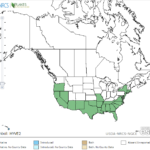Hydrocotyle verticillata
USDA, NRCS. 2018. The PLANTS Database (http://plants.usda.gov, 28 March 2018). National Plant Data Team, Greensboro, NC 27401-4901 USA.
Illustration: USDA-NRCS PLANTS Database / Britton, N.L., and A. Brown. 1913. An illustrated flora of the northern United States, Canada and the British Possessions. 3 vols. Charles Scribner’s Sons, New York. Vol. 2: 649.
What is Whorled Pennywort?
Physical Characteristics
Leaves:
- Disk- or egg-shaped
- Up to 2.5 inches in diameter
- 8-13 lobes
- Slender leaf stalks
- Leaf stalks up to 10.25 inches long (usually much shorter)
Flowers:
- Spike up to 6.69 inches long
- 2-7 few flowered spikelets
- Immobile
- Few sword-shaped bracts, not very noticeable
Fruit:
- Elliptical shaped
- 0.05-0.13 inches long
- 0.08-0.16 inches wide
- Egg-shaped seed
Stem:
- Thread-like
- Creeping
Where Does it Grow?
Whorled pennywort can be found along streams, in the shallow water or marshes, and on low, muddy ground.
Pros and Cons of Whorled Pennywort
The seeds of pennywort are used occasionally as food by waterfowl. Submerged portions of all aquatic plants provide habitats for many micro and macro invertebrates. These invertebrates in turn are used as food by fish and other wildlife species (e.g. amphibians, reptiles, ducks, etc.). After aquatic plants die, their decomposition by bacteria and fungi provides food (called “detritus”) for many aquatic invertebrates.


